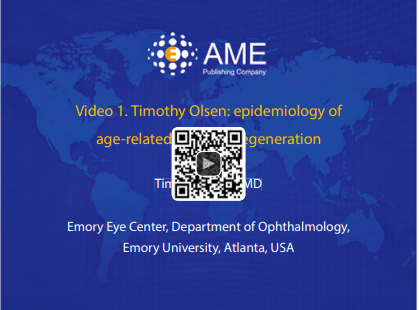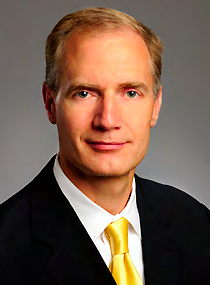Timothy Olsen: epidemiology of age-related macular degeneration
来源期刊: 眼科学报 |
2016年9月 第31卷 第3期: |
207-208
发布时间:
收稿时间:2024/11/30 21:10:37
阅读量:856
- 作者:
-
- 关键词:
-
-
- DOI:
-
doi: 10.3978/j.issn.1000-4432.2016.09.05
- 收稿时间:
-
2016-06-30
- 修订日期:
-
- 接收日期:
-
2016-07-04
Introduction
Timothy Olsen (Figure 1), MD, is former chair and
direc tor of Emor y Eye Center. He is a member of
the Vitreoretinal Surgery & Disease service where his
clinical expertise focuses on macular diseases, age-related
macular degeneration (AMD) and macular surgery.
Besides, he holds leadership positions in the American
Ophthalmologic Society (AOS), the American Academy
of Ophthalmology (AAO), the Association for Research
in Vision and Ophthalmology (ARVO) and serves as the
retina chair of the Preferred Practice Patterns (PPP) of
AAO.
Figure 1 Dr. Timothy Olsen, M.D
Interview
During the Zhongshan Medical Retina and Epidemiology
Symposium, I was honored to meet Dr. Olsen and invite
him for a brief interview to share his expertise on AMD.
In the interview, Dr. Olsen complimented on this
symposium, regarding Zhongshan Ophthalmic Center as
a large eye hospital that conducts excellent education and
training. When talking about AMD, he claimed that AMD
was the primary cause of blindness in many countries. After
comparing incidents of aging population in the USA and in
China, he found out that there was a dramatic increase in
AMD in the population of the individuals over age 50 and 60.
As the chairman of the retina PPP of AAO, he and
his group members look at evaluable evidence and give
an assessment based on the following process: (I) make
judgment about the article type; (II) ranking according
to methodology and grading the quality; (III) forming a
panel of experts in the field to assess the evidence; (IV)
a determination on whether to make a recommendation
for treatment is made by the consensus of the group.
Therefore, he held the idea that something with high
evidence was unlikely to be changed with new study. Dr.
Olsen also shared with us how to apply those evidences to
current practice, that is, to take these recommendations into
consideration and apply the treatment to the individuals
given the certain circumstances.
Dr. Olsen said that AMD was a complicated disease
with many different pathways involved. He thought that
the future for AMD would be the separation of different
disorders, with the aims to find out the reasons why
particular individuals would suffer from AMD and to
explore the best treatment to the individuals. In the end of
the interview, Dr. Olsen advised young ophthalmologists to
see more patients and read more. He also emphasized the
importance of evaluating the quality of literature and being
critical to the published articles.
For more details about this interview, readers can refer to
the following video (Figure 2).
Figure 2 Timothy Olsen: epidemiology of age-related macular
degeneration (AMD) (1).

Available online: http://www.asvide.com/articles/1156
1、Ye A. Timothy Olsen: epidemiology of age-related macular degeneration (AMD). Asvide 2016;3:382. Available online: http://www.asvide.com/articles/1156




